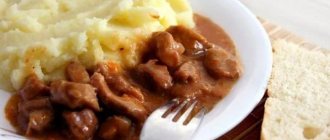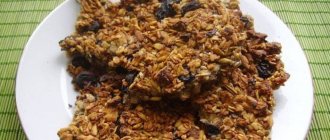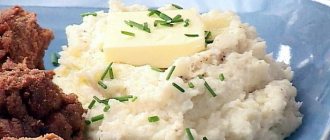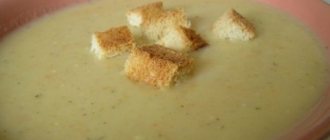| What can replace potatoes? | Description |
| Sweet potato | Sweet potatoes are called the closest relative of potatoes. Its color varies from white to deep orange. Sweet potatoes contain the same amount of beta-carotene as carrots. In French-style potatoes, it can replace the main ingredient, since it is perfect for baking, stewing, and making purees. |
| Carrot | Carrots are almost completely free of starch, which is not needed by those who are on a diet or adhere to proper nutrition. A vegetable rich in beta-carotene has a beneficial effect on the general condition of the body, improves vision, and strengthens the immune system. The presence of boiled carrots in a salad instead of potatoes can make the taste of a familiar dish more interesting. |
| Jerusalem artichoke | Jerusalem artichoke tubers are rich in fiber, which improves digestion. They can be boiled, like the potatoes themselves, added to salads, or eaten raw. If potato pancakes contain Jerusalem artichoke instead of potatoes, this will make the dish lighter and healthier. |
| Cauliflower | This vegetable is filled with numerous beneficial substances:
Cauliflower contains glucaraphanin, which prevents the development of ulcers and stomach cancer. Cauliflower makes a wonderful puree. It can be seasoned with fresh herbs and a small amount of butter. |
| Legumes | Among legumes, beans are a worthy alternative to potatoes. If you choose between red and white beans, it is better to take white ones. It would be appropriate:
Other varieties of beans are great for making purees. Many people use peas, chickpeas, lentils, and soybeans for this. |
Potatoes are a product without which it is difficult to imagine most of the dishes that are regularly present on the table of residents of many countries. This is a traditional ingredient that is added to Olivier, it is always present in the fur coat.
Excessive enthusiasm for potatoes also has a downside - the vegetable contains a lot of starch, it is too high in calories and carbohydrates. Its consumption leads to an increase in blood sugar levels.
Knowing all this, you should know what you can replace potatoes with so as not to lose your favorite tastes, but also not to harm your health.
Sweet potato
The closest vegetable to potatoes is sweet potatoes. Its second name is “sweet potato”. Due to their high beta-carotene content, the color of sweet potatoes can be bright orange, but almost all white vegetables are also found.
Sweet potato tubers contain a minimal amount of starch and a lot of fiber. They also have a low glycemic index. Sweet potatoes can be added to salads and boiled. It is suitable for baking in the oven with meat and other vegetables.
This is a good replacement for those who are on a diet and are watching their nutrition. In a vinaigrette, it can also fully replace potatoes, and the familiar taste will not suffer from this. It is better not to eat it raw.
How can you replace potatoes in soup, Olivier salad, vinaigrette and other dishes when on a diet?
There are natural products that are close to potatoes in taste and types of dishes that can be prepared from them.
Celery
They eat stems, roots and leaves.
Calorie content is 6 times less than that of potatoes; 8 times less carbohydrates, and 4 times less fat, but contains the same amount of fiber. Protein per 100 g of product is only 0.9 g. Glycemic index – 15.
Celery is rich in vitamins:
- A (83% of the daily value in 100 g) improves vision and skin, supports the immune system, and is responsible for reproductive function;
- C (43%) strengthens the immune system, promotes the absorption of iron, and participates in redox reactions.
In addition, celery is high in sodium, which has a beneficial effect on the functioning of the kidneys and bladder. The plant has a diuretic effect.
Attention! Contraindications to eating celery in large quantities are urolithiasis and thrombophlebitis.
Celery tubers are fried like potatoes in a small amount of olive oil with chopped onions and added to the soup. Salads are prepared from the stems and leaves.
Low calorie content and low carbohydrate content serve as the basis for the use of this vegetable in dietary nutrition for weight loss.
Daikon, or Japanese (Chinese) radish
Root vegetable, subspecies of radish.
Calorie content is 3 times less than that of potatoes; contains less carbohydrates - 8 times, proteins - 2 times, fats - 2 times. Dietary fiber – the same amount. GI – 15.
Carrot
The well-known carrot, which fills the body with beta-carotene, antioxidants, beneficial vitamins and microelements, can replace potatoes. Regular consumption of carrots helps regulate blood sugar levels and keep them under control - this is important for people with diabetes.
Carrots are great for eating raw. It should become an integral part of fresh salads, soups, and side dishes. In cutlets, it can replace potatoes if such a component is mandatory and cannot be avoided. Many people like to treat themselves to carrot chips - they are a delicious and healthy snack.
Few people know that regular consumption of carrots, raw and cooked, improves skin condition and helps stabilize blood pressure levels. The fiber contained in the vegetable quickly normalizes digestive processes and eliminates periodic discomfort.
Chemical composition, microelements and nutritional value of potatoes
Among the main vitamins that the tuber is rich in:
- C – 100 g of product contains up to 28% of the daily value;
- B6 – 27%.
However, during the cooking process their quantity decreases.
Microelements:
- Potassium – 19%. Reduces the risk of cardiovascular diseases, normalizes oxygen exchange.
- Manganese – 26%. Strengthens the effect of insulin, participates in the production of thyroid hormones.
- Chrome – 20%. Regulates carbon and fat metabolism. Its deficiency causes cravings for sweets.
- Magnesium – 12%. "Mineral of the Heart" Participates in the formation of new cells and strengthening the nervous system.
In addition, the composition contains omega-3 fatty acids - 0.1 g (10%), as well as dietary fiber - 1.4 g (7%).
Calorie content, BJU, glycemic index of potatoes
The calorie content of potatoes is 77 kcal (per 100 g of raw product), which is 5% of the average daily requirement. This indicator varies depending on the cooking method:
- fried potatoes – 192 kcal;
- boiled in its jacket – 85 kcal;
- chips – 292 kcal.
100 g of product contains:
- proteins – 2 g (2% of daily value);
- fats – 0.4 g (0.6%);
- carbohydrates – 16.3 g (12.0%).
Carbohydrates are mainly starch, which is what gives potatoes a bad reputation.
Why starch is harmful and beneficial
Potatoes contain a lot of carbohydrates in the form of starch (12% of the daily value per 100 g). Because of this nutrient, WHO does not include potatoes among healthy natural foods. It is believed that the conversion of starch into glucose in the body leads to obesity, heart attack, stroke, and type 2 diabetes.
However, upon closer examination the situation looks more optimistic:
- Some part of the starch after heat treatment turns into stable (resistant), i.e. insoluble in the stomach. In the large intestine, it feeds bacteria that convert it into saturated fatty acids (butyric acid), which reduce inflammation, protect the intestinal wall, and are associated with a lower risk of colorectal cancer.
- Resistant starch, unlike regular starch, lowers blood glucose levels.
- Both resistant starch and soluble fiber promote a feeling of fullness and discourage overeating.
Unfortunately, there is little resistant starch in boiled potatoes - only 3.2%, which is four times less than usual.
The glycemic index (GI) indicates the amount of glucose formed in the blood two hours after eating a product. According to this indicator, products are divided into three groups:
- with a low GI value – 0-55;
- with average – 56-69;
- with high – 70 and above.
The change in blood sugar level 2 hours after consuming glucose is taken as 100.
The glycemic index of potatoes varies depending on the method of preparation:
- mashed potatoes – 90;
- chips – 80;
- boiled in its uniform – 65.
So, potatoes contain few calories and fats, but a lot of carbohydrates, mostly simple ones with a high GI, due to which the vegetable is not recommended for people who are prone to obesity or suffer from diabetes.
However, properly cooked potatoes (boiled in their skins or baked in the oven with the peel) without oil can become a dietary product, especially in combination with low-carbohydrate foods (for example, meat with a small portion of baked potatoes and salad). The main thing is not to eat a lot of tubers and, if possible, replace them with other products.
Important! It is necessary to take into account the individual glycemic response to potatoes. It is useful to have a glucometer and find out your response to foods.
Jerusalem artichoke
Jerusalem artichoke tubers are a real storehouse of fiber that is beneficial for the body. Thanks to it, the functioning of the digestive system improves. In addition, regular consumption of Jerusalem artichoke will saturate the body with vitamins B and C. Tubers contain calcium and silicon, magnesium, and manganese.
Healthy tubers can be consumed fresh. They are used to prepare a variety of vegetable salads. Jerusalem artichoke is suitable for boiling, as it most closely resembles potatoes. It can be added raw to minced meatballs.
Turnips and turnips
This unpretentious garden crop in Rus' was used for food long before potatoes appeared in the garden beds (remember the expression “simpler than steamed turnips”?), but today it is practically forgotten by many in favor of “second bread”. And quite undeservedly. Let's explain why.
Turnips are not nearly as starchy (and therefore not as high in calories) as potatoes - about 30 kcal per 100 g.
Turnips contain beta-carotene, vitamins A, C, PP, B1, B2, E, fiber, vegetable protein, a lot of calcium and succinic acid (a universal biostimulant). Turnip helps fight hypovitaminosis, stimulates the secretion of gastric juice, enhances intestinal motility, and improves food absorption. The juice of fresh root vegetables is also used for medicinal purposes - as a remedy with diuretic, antiseptic, anti-inflammatory, wound healing and analgesic effects.
Cauliflower
Many people cannot understand how cauliflower can replace potatoes. If you prepare the vegetable correctly and add just a little spice, which can hide the characteristic cabbage smell, then the prepared puree with fresh herbs can be mistaken for potato puree.
This option is simply a godsend for those who count calories and do not want to eat carbohydrate potatoes.
Cauliflower will be an excellent addition to soups and broths. It can be added to salads. The advantage is that it has a light, sweetish taste, but the vegetable is able to quickly absorb spices and other flavors.
Against the general background, cabbage will not stand out separately. If the cooked cauliflower puree retains the smell of the vegetable, you can add a little ghee or fresh butter to it.
Links to recipes for first courses without potatoes
- Homemade noodle soup is on this page
- See tomato soup with seafood here
- The first dish in the form of cauliflower puree from Yulia Vysotskaya - click here
- Rich vegetable soup - follow this link
- See real Georgian Kharcho here
Cook deliciously and be healthy!
Subscribe to our public pages on social networks and stay tuned for new simple recipes!
Find out how you can replace potatoes in terms of taste in dishes, side dishes, mashed potatoes, and diets.
According to taste properties
You can replace potatoes in various recipes: soups, salads, etc.
1. Beans.
Ideal replacement. It is better to use white beans. Pre-soak for 8 hours and boil for 1 hour.
2. Any grains from the legume family. Like beans, they need to be pre-soaked and then boiled. Beans are more reminiscent of potatoes in size and taste, so they are listed in a separate item.
3. Turnips, rutabaga, parsnips.
Although these vegetables are now sometimes difficult to find in stores, until the 18th century they replaced potatoes.
4. Carrots, beets, cauliflower, Jerusalem artichoke (earthen pear), zucchini. Replace boiled.
5. Rice and other grains.
Can replace potatoes as a side dish.
What can you replace mashed potatoes with?
1. Porridge from semolina class “M”. Some, perhaps not entirely honest manufacturers, can replace potatoes, for example, in dumplings with potatoes.
2. Peas, which can be replaced with other grains from the legume family, such as lentils. It needs to be soaked in water for 8 hours, then boiled in low boiling water for 50 minutes. Puree using a blender or potato masher. You can add a mixture of fried onions and carrots.
3. You can puree boiled celery root. Keep in mind that this dish has a specific taste, not everyone likes it, but it has less calories.
How to replace potatoes on a diet?
Leeks, any cabbage and radishes have similar properties, but have fewer calories. It is worth noting that it is wrong to replace potatoes with cereals, because they contain more calories.
If you want to find a dietary substitute for fried potatoes, try using celery root. This method is mentioned in the Dukan diet. You can fry it in the same way as potatoes, only there are two nuances:
1. You need to peel celery as quickly as possible or wear gloves so as not to stain your hands.
2. It cooks faster than potatoes.
How to replace potatoes as a side dish?
Rice, buckwheat, noodles, cabbage, pearl barley, millet, beans.
Most often they are passed by undeservedly. This is because celery root, round like a ball, ginger-like Jerusalem artichoke and oblong sweet potato, the season of which is now in full swing, appeared en masse on our shelves just a few years ago. But these roots are rich in vitamins and minerals, and they have a unique, incomparable taste. And, by the way, all of them can become an original replacement for potatoes.
Legumes
Beans and other legumes are an excellent substitute for potatoes. It is best to add beans to soup, cabbage soup or borscht. It is better to use white varieties. You can also make puree from legumes. Dried peas are more suitable for this dish.
It can be replaced with chickpeas or lentils to taste. These same legumes are also used to prepare delicious and satisfying pureed soups.
Legumes contain vegetable protein, a minimal amount of fat, and a lot of dietary fiber. Regular consumption of legumes helps stabilize blood pressure and lower cholesterol.
There are more than enough options to replace potatoes. Each of the alternative products has a lot of advantages and is filled with useful substances. You can choose what will replace potatoes in Olivier, in fur coats or cutlets according to your taste, making the dishes healthier.
Potatoes are a universal root vegetable that is used to prepare both first and second courses. But if you want to take a little break from it or have a goal to lose weight, then you can prepare several soups without skipping this vegetable.
Beans
For example, the familiar beans, available in any store and growing well in the middle zone. Why not? Its large bean seeds contain:
- abundance of dietary fiber;
- up to 60% carbohydrates (starch and other sugars);
- up to 30% valuable vegetable protein (it is close in composition to meat proteins and is absorbed by the human body by 75%);
- microelements (potassium, phosphorus, copper, zinc, etc.);
- vitamins (carotene, etc.).
In the diet of many southern peoples, beans occupy an important place, and our housewives widely use them to prepare various dishes. Beans can be stewed, boiled, canned, they have proven themselves excellent both as a separate side dish and as a component of soups, salads, casseroles, stews, and pie fillings.
Moreover, thanks to the abundance of varieties and varieties of beans, you can choose them to your taste - some varieties, when cooked, retain their density and shape, remaining elastic, while others, soft and oily, “boil” almost into mush.
With a calorie content of about 123 kcal per 100 g, boiled beans are considered a dietary product (for comparison, the calorie content of boiled potatoes is about 85 kcal per 100 g). Just like potatoes, beans are suitable for feeding people with gastrointestinal problems, for example, low stomach acidity.
- 5 incredibly delicious white bean dishes
What unusual and tasty things can you make from white beans? Find out from our article.
Rice soup with beef
Required Products:
- beef – 400 g;
- rice - 8 tablespoons;
- bay leaves – 3 pieces;
- carrots – 2 pieces;
- sunflower oil – 5 tablespoons;
- onions – 2 pieces;
- table salt – 50 g.
Preparation:
- Trim excess fat from the meat and remove the veins, rinse it thoroughly and cut into pieces ranging in size from 3 to 5 centimeters.
- Place the meat in a pan and add hot water for faster cooking. Add salt and cook over low heat for about 40 minutes.
- Wash the uncooked rice thoroughly and set it aside.
- Peel the carrots, rinse them and rub them through a grater with the smallest holes.
- Peel, rinse and chop the onions.
- It’s good to heat the oil in a frying pan and put the carrots and onions in it, do not saute them, stirring.
- When the meat has cooked for the required time, add rice.
- Add the sauteed vegetables to the broth, stir and continue cooking for another half hour.
- Serve the dish by adding fresh herbs to the plates.
Soup with sorrel and egg
Ingredients:
- fresh sorrel – 450 g;
- eggs – 7 pieces;
- bay leaves - 2 pieces;
- large carrots - 1 piece;
- onion – 1 head;
- oil – 3 tablespoons;
- salt – a couple of pinches;
- spices - to taste.
Preparation:
- Peel the carrots and grate them.
- Peel the onion heads, rinse under cold water and chop into small cubes.
- Pour oil into the bottom of the frying pan and place it on the fire.
- When the oil starts to bubble, add the onions and carrots and simmer until soft.
- Wash the sorrel leaves thoroughly and chop them.
- Fill the pan with water and place it on maximum heat.
- After boiling, add stewed vegetables, sorrel, bay leaves, spices and salt.
- Cook for 10 minutes and add the beaten egg mixture.
- Stir and turn off the heat.
The dish is ready to serve.
Tomato soup
Grocery list:
- tomato juice – 2 l;
- carrots - 1 root vegetable;
- parsley – 1 bunch;
- bell pepper – 2 pieces;
- bay leaves – 3 pieces;
- ground cinnamon – 1 teaspoon;
- salt – 1 teaspoon.
How to make soup:
- Pour tomato juice into a saucepan, add salt and put on fire.
- After boiling, place the peeled and thinly sliced carrots into it.
- Add bell pepper chopped into half rings.
- Add mustard and place bay leaves in boiling juice.
- Cook everything together for another 20 minutes and at the end add a little, stir and remove from the stove.
- Pour into plates and serve, sprinkled with herbs.
Light chicken soup
List of ingredients:
- chicken fillet – 600 g;
- vermicelli – 0.5 cups;
- carrots – 2 pieces;
- dried dill – 1 tablespoon;
- onion – 1 piece;
- salt – 1 dessert spoon;
- water – 4 l.
Recipe:
- Pour water over the chicken fillet and place on the fire.
- After boiling, boil for 5 minutes, drain the water and rinse the meat.
- Place it again in a clean container, pour in 4 liters of water and let it cook.
- When the water boils, place the peeled onion in it.
- After half an hour, add the carrots, cut into half rings, and cook for another quarter of an hour.
- Remove the onion from the broth and add vermicelli.
- Cook for another 10 minutes, and then add the dill, stir, turn off the heat and let it brew for another 20 minutes.
Afterwards it can be served for lunch.
Diet Bonn soup for weight loss - recipe and reviews
In this article I will tell you how to prepare a nutritious and tasty lentil soup. Many people, when losing weight or eating right, refuse soup in favor of main courses and salads. But in vain! Soup is not just the first thing for lunch. This is a dish that is well digestible, satiates and warms. And don’t forget about the beneficial properties of the ingredients, which are often more in the soup than in any other dish. Lentils are a legume that consists of vegetable protein and complex carbohydrates. Therefore, it is often used in weight loss menus: it takes a long time to digest and saturates well. I won’t be wrong if I say that the most popular lentil dish is soup. Of course, I didn’t immediately fall in love with him and learn to cook.
Buckwheat soup
Required Products:
- meat broth - 2 l;
- buckwheat – 150 g;
- seasoning for soup - 1 dessert spoon;
- bell pepper – 200 g;
- dill – 1/2 bunch;
- salt to taste.
Preparation:
- Pour well-washed buckwheat into boiling meat broth and cook for a quarter of an hour.
- During this time, wash, remove seeds and cut into cubes the sweet pepper.
- Rinse fresh dill and chop it finely.
- When the buckwheat has cooked for the required time, add pepper to the pan and cook for another 10 minutes.
- Lastly, add spices, herbs and, if necessary, salt into the broth.
- Let it boil for about 5 minutes and remove from the stove.
- Serve in portions with sour cream.
Meatball soup
List of ingredients:
- minced pork – 700 g;
- carrots – 200 g;
- garlic – 4 cloves;
- rice – 150 g;
- onion – 200 g;
- eggs – 2 pieces;
- parsley – 1 bunch;
- ground pepper – 1/3 teaspoon;
- butter – 50 grams;
- salt – 1 teaspoon.
Cooking process:
- Place minced meat, thoroughly washed raw rice, eggs, ground pepper, salt and very finely chopped garlic into a deep bowl.
- Knead the minced meat into a homogeneous mixture and form into small meatballs.
- Fill a saucepan with 4 liters of water, place the meatballs in it and let it cook.
- Grate the carrots and chop the onion into cubes.
- Melt a piece of butter in a frying pan and fry the onion until soft.
- After 3 minutes, add carrots and simmer for another 5 minutes.
- After the water boils, you need to carefully stir the meatballs.
- Place the vegetable sauté from the frying pan into the boiling broth and cook for half an hour.
- Pepper, salt and add chopped parsley to the dish.
- Remove from heat and let sit for a while before serving.











